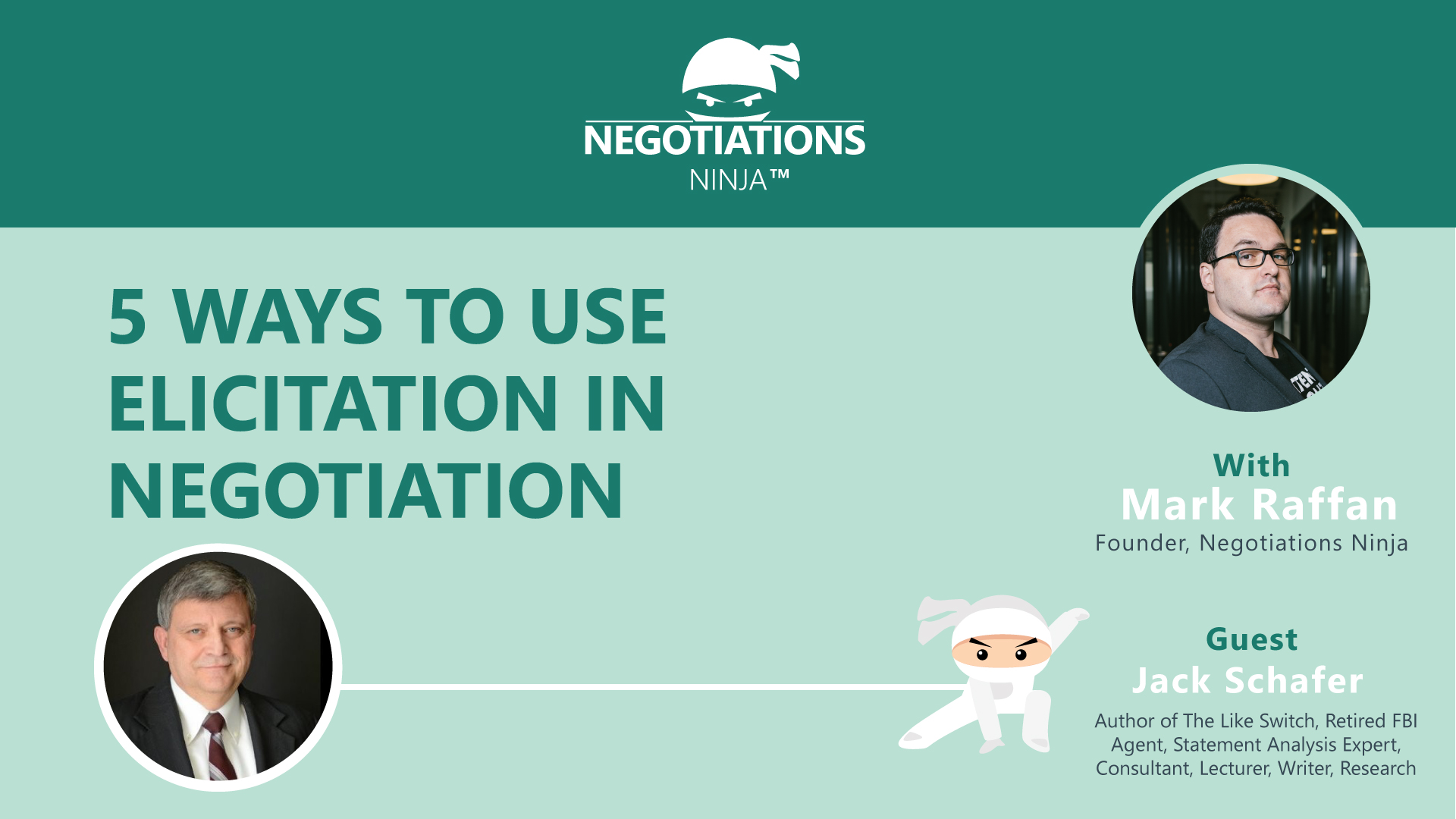Jack Schafer spent much of his career in counterintelligence in the FBI. In this episode of Negotiations Ninja, we’ll discuss topics from Jack’s newest book, “The Truth Detector: An Ex-FBI Agent’s Guide for Getting People to Reveal the Truth” We talk about the concept of elicitation, presumptive statements, how to shift power dynamics in the conversation—and how to use it them in business negotiations. Don’t miss this fascinating look into the inner workings of a spy’s career.
Outline of This Episode
- [2:14] Learn more about Jack Schafer
- [2:55] Technique #1: Presumptive Statements
- [8:30] How to shift power in a negotiation
- [11:08] The use of time in a negotiation
- [13:12] Who has the authority?
- [15:04] Technique #2: Use the phrase “I’ll bet…”
- [18:11] Uncovering your counterpart’s objections
- [20:23] Technique #3: Bracketing
- [22:19] Technique #4: Reported Facts
- [24:00] Technique #5: The Well Technique
What is elicitation?
Elicitation is a conversation where you want to predispose the counterpart to tell you sensitive information without them realizing they’re revealing it. You have to set up the right environment based on psychological principles. The first step of elicitation is to get someone to like you.
What do you do next? Don’t ask questions. If you start by asking questions, the other person immediately begins to question what information you’re trying to uncover. Elicitation starts with making statements.
Technique #1: Presumptive Statements
Elicitation is based on several psychological principles. The most powerful is the need to correct. Correcting someone else makes you feel good about yourself and gives you a feeling of superiority.
To make an incorrect statement, you have to let go of your ego. The tool associated with the need to correct is called “The presumptive.” So you make a statement that’s either true or false. The other person will be compelled to correct you.
During a class on elicitation, Jack looked at one of his students and said, “That’s a pretty good observation you made for a Sophomore.” She bit her lip because she knew what he was trying to do. But five minutes later, she blurted out, “You know I’m a senior!” The urge to correct someone can be overpowering.
Technique #2: Use the phrase “I’ll bet…”
Jack would look at someone and say, “I’ll bet you’re thinking…” and complete a statement. The goal is to voice what you think they’re thinking internally—but your statement doesn’t have to be correct. The other person will affirm, deny, or add things to it.
There’s also something called the lip purse, which is a slight outward movement of your lips. If you’re talking about delivery times, logistics, and money, and suddenly you see someone’s lips purse, you’ll know that person formed a negative opinion about what you just said.
When you see this happen, you have to get that person to change their mind before they voice their concern. It’s based on the psychological principle of consistency. People live up to what they say. So if someone vocalizes their thought that something costs too much and they won’t buy it, they won’t buy it.
Making a decision causes anxiety. Once a decision is made, the anxiety is lessened. People don’t want to reintroduce anxiety into their life. So what do you say? “I’ll bet you’re thinking this is too much money…but let me tell you the cost-benefit of this…”
Technique #3: Bracketing
Jack wanted to buy his wife a diamond ring as cheaply as possible. To find out what the markup was and what the salesperson’s commission was, Jack said “Geez, you probably make a 5–10% commission on this.” The salesperson immediately told him he only made 3%. So Jack said, “Geez, the markup must be like 15%” and the salesperson automatically told him it was 25%.
If he had directly asked him what the commission or markup was, he’d say “None of your business.” Then Jack asked, “I bet you’re not authorized to give a 10% discount.” After which Jack found out that if he wanted more of a discount, he’d have to ask his boss.
So Jack told the salesperson to ask his boss for a 20% discount. He came back and said, “Yes.”
Technique #4: Reported facts
You can say something like, “I read on the internet that your company is having trouble with supply chain issues…” They’ll either correct you or share the issues. How do you defend yourself against that? Say, “Pull up the article and show me and then I’ll talk to you.” Most people don’t do that. Why? Truth bias. You want to believe someone is telling the truth until they give you a reason not to. When you’re negotiating, people will believe you until they don’t.
Technique #5: The Well Technique
Ask someone a yes or no question. If they begin their response with the word “well,” it means they’re going to give you an answer they know you’re not expecting. Jack told his kid, “Go do your homework.” When his son came out of his room, he asked him if he was done. His son said, “Well…” and he immediately told him to get back in his room and get it done.
How did Jack know he hadn’t done his homework? If someone starts with the word “Well,” they’ll give you any answer other than yes. It’s just another way of saying no. It’s a powerful way to test voracity.
Elicitation is a powerful tool. Learn more about leveraging elicitation and presumptive statements in this episode of Negotiations Ninja!
Resources & People Mentioned
Connect with Jack Shafer
- The Truth Detector: An Ex-FBI Agent’s Guide for Getting People to Reveal the Truth
- The Like Switch: An Ex-FBI Agent’s Guide to Influencing, Attracting, and Winning People Over
Connect With Mark
- Follow Negotiations Ninja on Twitter: @NegotiationPod
- Connect with Mark on LinkedIn
- Follow Negotiations Ninja on LinkedIn
- Connect on Instagram: @NegotiationPod




